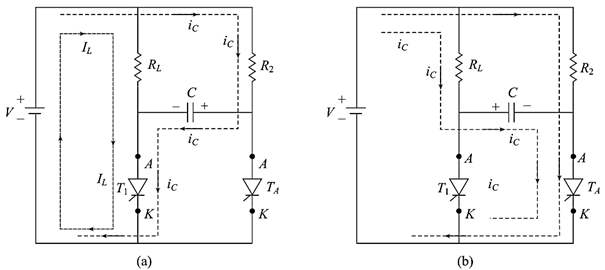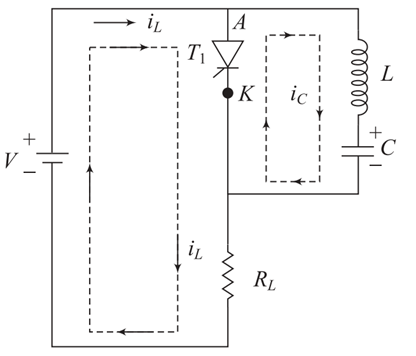Ratings of SCR
Ratings of SCR
All semiconductor devices have definite limits to their capability and exceeding these even for short times will result in failure, loss of control, or irreversible deterioration. All thyristors, therefore, have to be used within their limits and this must include extreme conditions as may exist during circuit faults and it must take into account load, supply system, temperature and environmental variations. Therefore, the reliable operation of the device can be ensured only if its ratings are not exceeded under all operating conditions. The objective of this section is to discuss the various SCR ratings.
Voltage Ratings
It is essential that the voltage capability of a thyristor is not exceeded during operation even for a very short period of time. Therefore, the voltage rating of the device should be high enough to withstand anticipated voltage transients as well as the repetitive OFF state and reverse-blocking voltages.
- Working peak-off state forward voltage (VDwm) This is the maximum instantaneous value of the forward OFF state voltage that occurs across the thyristor excluding all repetitive and non-repetitive transient voltages.
- Repetitive peak-off state forward voltage (VDrm) It refers to the peak transient voltage that a thyristor in the OFF state can block repeatedly in the forward direction. This rating is specified at a maximum allowable junction temperature with gate circuit open or with a specified biasing resistance between the gate and cathode terminals.
- Non-repetitive peak-off-state forward voltage (VDSM) This is the maximum instantaneous value of any non-repetitive transient OFF state voltage that occurs across a thyristor.
- Working peak reverse voltage (VRWM) This is the maximum instantaneous value of the reverse voltage that occurs across the device excluding all repetitive and non-repetitive transient voltages.
- Repetitive peak reverse voltage (VRRM) This is the peak reverse transient voltage that may occur repeatedly in the reverse direction at the allowable maximum junction temperature. If this rating is exceeded, the SCR may be damaged due to excessive junction temperature.
- Non-repetitive peak reverse voltage (VRSM) This is the maximum transient reverse-voltage which can be safety blocked by the thyristor. The transient reverse voltage rating can be increased by inserting a diode of equal current rating in series with the thyristor.
- On state voltage (VT) This is the voltage drop between anode and cathode with specified forward ON state current and junction temperature. Its value is of the order of 1 to 1.5 V.
- Gate trigger voltage (VGT) This is the minimum gate voltage required to produce the gate trigger current.
- Voltage safety factor (Vf) To avoid damage to a thyristor due to uncertain conditions, normal operating voltage is kept well below the VRSM value of the device. The operating voltage and VRSM (or peak inverse voltage VPIV) value are related by the voltage safety factor Vf that is defined as
{{V}_{f}}=\frac{{{{V}_{{RSM}}}\,\text{Peak}\,\text{Reverse}\,\,\text{Voltage}}}{{\sqrt{2}\times \text{RMS}\,\text{value}\,\text{of}\,\text{input}\,\text{voltage}}}$
- Forward dV/dt rating [rate of rise of OFF state voltage] The dV/dt rating of a thyristor indicates the maximum rate of rise of anode voltage that will not trigger the device without any gate signal. If the rate of rise of forward voltage is higher than the specified maximum value, it may cause switching from the OFF state to the ON state.
Current Ratings
The current carrying ability of the thyristor is determined by the temperature at its junction. Since the thyristor is made up of a semiconductor material, it’s thermal capacity is, therefore, quite small. Hence, even for short over currents, the junction temperature may exceed the rated value and the device may be damaged. In this section, current ratings of SCR are discussed for both repetitive and non- repetitive type of current waveforms.
- Average On-state Current (ITAV) As the forward voltage drop across conducting SCR is very low, the power loss in an SCR depends mainly on forward average on state current ITAV. The average current rating of a phase controlled thyristor results in different conduction angles. This may result in an increased voltage drop across the device, and the average power dissipation may increase raising the junction temperature beyond the safe allowable limit. The permissible average current should, therefore, decrease with the decrease in conduction angle. This current rating is of repetitive type and is specified at the maximum junction temperature. This rating varies with the case temperature.
- RMS On-state Current (IRMS) By the definition of rms values, the rms and average values are identical for a direct current. The rms current rating can be of importance when applying thyristors to high peak current, low duty cycle waveforms. Although, the average value of the waveform may be well within the ratings, it may be that the allowable rms rating is being exceeded. In order to prevent excessive heating in resistive elements of a thyristor, such as metallic joints, leads and interfaces, the rms value is given in the specification sheet of the SCR by all manufacturers. This current rating is also of repetitive type and is specified at the maximum junction temperature.
- Surge Current Rating (ITSM) (Non-repetitive, Peak-on State Current) When an SCR is working within its repetitive voltages and current ratings, its permissible junction temperature is never exceeded. However, a thyristor may be subjected to abnormal operating conditions due to faults or short circuits. In order to accommodate these unusual working conditions, the surge current rating is also specified by the manufacturers. The surge current rating indicates the maximum possible non-repetitive or surge current, the device can withstand and this may occur due to non-repetitive faults or short-circuits during the lifespan of a thyristor.
- I2t Rating I2t is the maximum allowable non-recurring value of the square of the instantaneous current integrated with respect to the time. This rating is required to coordinate with the fast acting fuse for protecting the device during an overload or fault conditions. This rating is the measure of the thermal energy that the device can absorb for a short time before the fault is cleared by the fuse. It is usually specified for fault currents lasting for less than or equal to one half period at the supply frequency of 50 or 60 Hz.
- di/dt Rating The di/dt rating of a thyristor indicates the maximum rate of rise in anode to cathode current. The maximum rate of change of current that the device can withstand during its ON state is called its critical rate of rise of current. The value of critical rate of rise in current for a particular device is always specified at its highest value of junction temperature that it can safely bear. If the rate of rise in anode current is very rapid compared to the spreading velocity of carriers across the junctions during the turn-on period, the local hot spot heating occurs due to high current density in the junction regions. This increases the junction temperature beyond the safe limit and the device may be damaged.
- Holding Current (IH) The holding current may be defined as the minimum value of anode current below which the device stops conducting and returns to its OFF state. The value of this current is very small, usually in milliamperes. The holding current occurs when the current in a device in ON state is being decreased till it turns off. Therefore, this current is associated with the turn-off process.
- Latching Current (IL) The latching current of a device may be defined as the minimum ON state current required to keep the device in the ON state after the triggering pulse has been removed.
- Gate Current [Igmin and Igmax] The current which is applied to the gate of the thyristor for control purposes, is known as its gate current. It may be of two types, the minimum gate-current (Igmin) and maximum gate current (Igmax). The minimum value of current required at the gate for triggering the device is called as the minimum gate current, Igmin.
Power Rating
The power-generated in the junction region of a thyristor in a normal operation consists of the following components of dissipation. 1. Forward-conduction. 3. Turn-off or commutation. 2. Turn-on switching 4. Forward and Reverse blocking. 5. Gate pulse triggering.
- Forward Conduction Loss The average anode current multiplied by the forward voltage drop across the SCR is the average power dissipated in the thyristor. ON state conduction losses are the major source of junction heating for normal duty cycle and power-frequencies.
- Turn-on Losses Since the switching process takes a finite time, there is a relatively high voltage across the thyristor while a current flows. Therefore, this loss is rather higher than the turn-off loss.
- Turn-off Losses The turn-off power losses arises during the time of decay of reverse current, according to the product of the instantaneous values of reverse current and reverse voltage, may reach high peak values up to several kilowatts.
- Forward and Reverse Blocking Losses In the forward blocking region, anode is made positive with respect to cathode and the anode current is the small forward leakage current. Therefore, the forward blocking power loss is the integration of product of the forward blocking voltage and forward leakage current. Similarly, reverse power loss occurs in reverse blocking region. The forward power loss is generally small compared to the conduction-loss.
- Gate Power Loss (Pgav) The gate power loss is the mean power loss due to gate current between the gate and main terminals. Gate losses are negligible for pulse types of triggering signals.
Thermal Ratings
The following are the main thermal ratings of the device.
- Junction Temperature (Tj) A thyristor’s ability to block forward voltage applied to it can only be maintained within a specific junction temperature limit. If this junction temperature is exceeded, the thyristor will switch into the ON state even though no gate current may be flowing. This is usually the deciding factor in controlling the maximum current that can be carried by the thyristor for any significant period of time. The operating junction temperature range of thyristors varies for the individual types.
- Transient Thermal Impedance (ZTH) This is the resistance between the junction of a thyristor and its cooling surfaces. It is invariably expressed as degree centigrade temperature difference per watt of energy dissipated. The larger the thyristor, the smaller will be its thermal resistance value.
Turn-on and Turn-off Time Ratings
Selecting a thyristor for a particular application is very much dependent on the turn-on and turn-off time. Fast switching thyristors have very low values of turn-on and turn-off time. This is achieved by gold doping in silicon. Presence of gold in thyristors reduces minority carrier life-time but increases leakage currents. For faster devices leakage current is more and hence relatively lower values of voltages VRWM and VOWM.
latest video
news via inbox
Nulla turp dis cursus. Integer liberos euismod pretium faucibua









